Marketing Strategies - The Fast-food Industry of Singapore
VerifiedAdded on 2022/09/01
|13
|2949
|25
AI Summary
Contribute Materials
Your contribution can guide someone’s learning journey. Share your
documents today.

MARKETING STRATEGIES
Secure Best Marks with AI Grader
Need help grading? Try our AI Grader for instant feedback on your assignments.
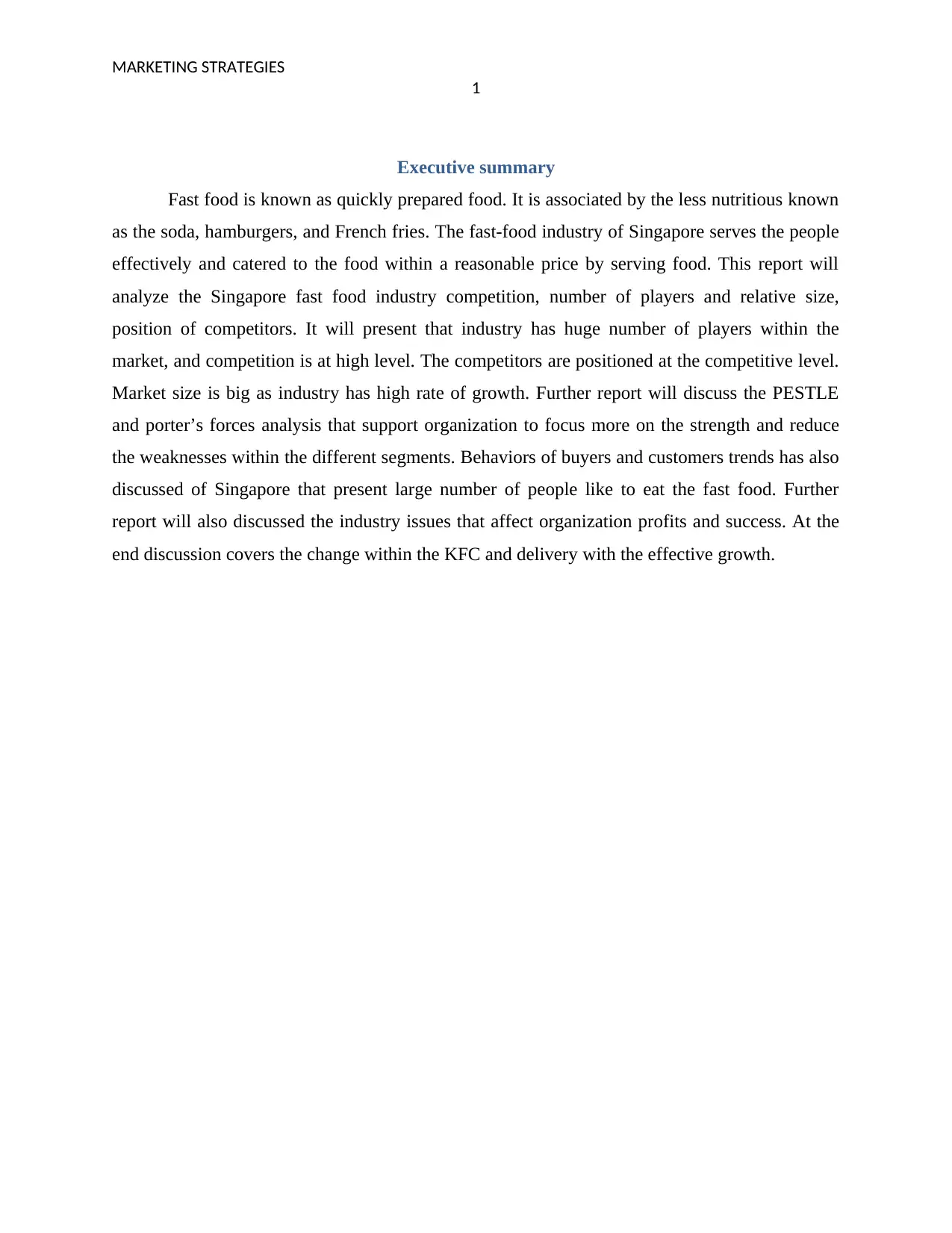
MARKETING STRATEGIES
1
Executive summary
Fast food is known as quickly prepared food. It is associated by the less nutritious known
as the soda, hamburgers, and French fries. The fast-food industry of Singapore serves the people
effectively and catered to the food within a reasonable price by serving food. This report will
analyze the Singapore fast food industry competition, number of players and relative size,
position of competitors. It will present that industry has huge number of players within the
market, and competition is at high level. The competitors are positioned at the competitive level.
Market size is big as industry has high rate of growth. Further report will discuss the PESTLE
and porter’s forces analysis that support organization to focus more on the strength and reduce
the weaknesses within the different segments. Behaviors of buyers and customers trends has also
discussed of Singapore that present large number of people like to eat the fast food. Further
report will also discussed the industry issues that affect organization profits and success. At the
end discussion covers the change within the KFC and delivery with the effective growth.
1
Executive summary
Fast food is known as quickly prepared food. It is associated by the less nutritious known
as the soda, hamburgers, and French fries. The fast-food industry of Singapore serves the people
effectively and catered to the food within a reasonable price by serving food. This report will
analyze the Singapore fast food industry competition, number of players and relative size,
position of competitors. It will present that industry has huge number of players within the
market, and competition is at high level. The competitors are positioned at the competitive level.
Market size is big as industry has high rate of growth. Further report will discuss the PESTLE
and porter’s forces analysis that support organization to focus more on the strength and reduce
the weaknesses within the different segments. Behaviors of buyers and customers trends has also
discussed of Singapore that present large number of people like to eat the fast food. Further
report will also discussed the industry issues that affect organization profits and success. At the
end discussion covers the change within the KFC and delivery with the effective growth.
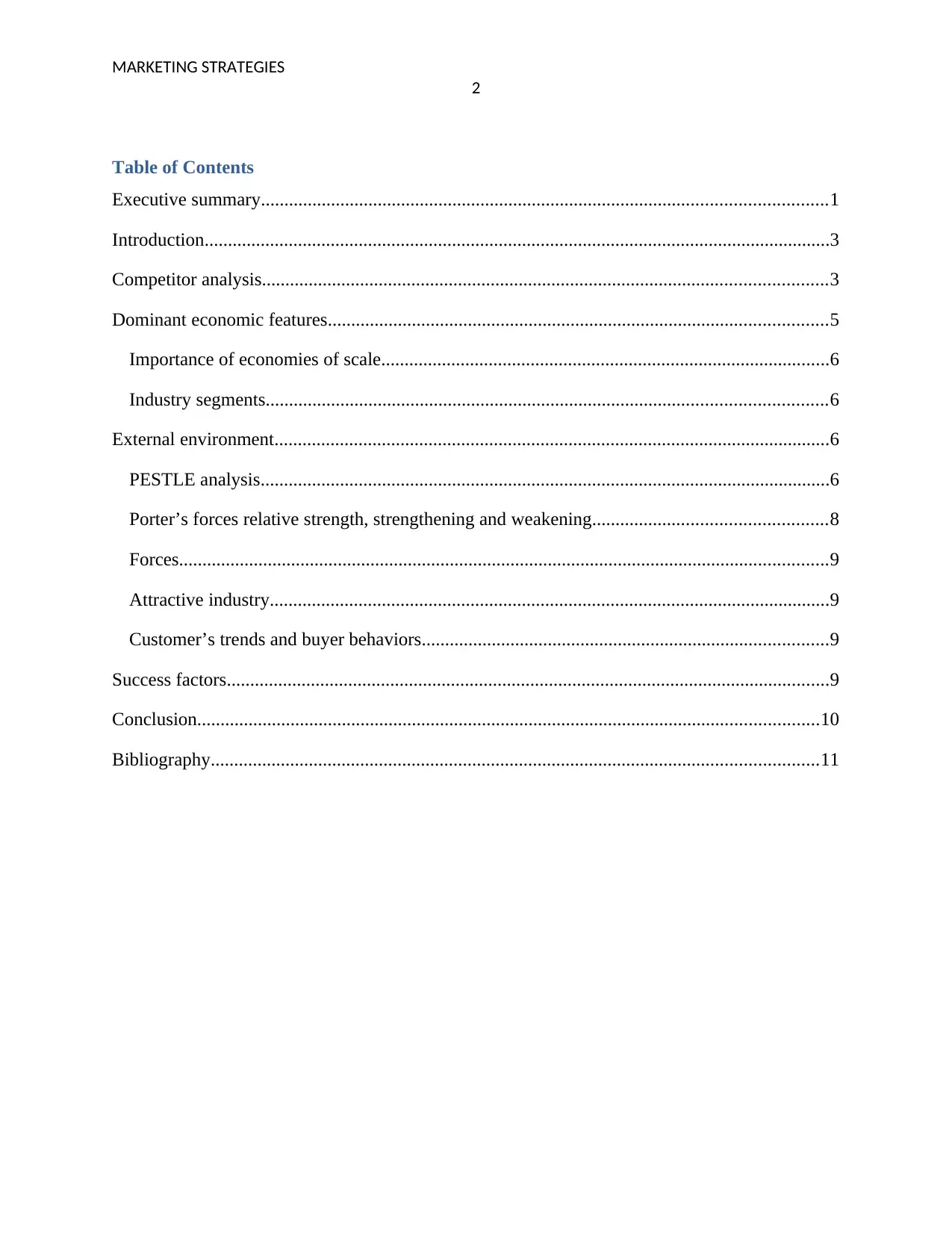
MARKETING STRATEGIES
2
Table of Contents
Executive summary.........................................................................................................................1
Introduction......................................................................................................................................3
Competitor analysis.........................................................................................................................3
Dominant economic features...........................................................................................................5
Importance of economies of scale................................................................................................6
Industry segments........................................................................................................................6
External environment.......................................................................................................................6
PESTLE analysis..........................................................................................................................6
Porter’s forces relative strength, strengthening and weakening..................................................8
Forces...........................................................................................................................................9
Attractive industry........................................................................................................................9
Customer’s trends and buyer behaviors.......................................................................................9
Success factors.................................................................................................................................9
Conclusion.....................................................................................................................................10
Bibliography..................................................................................................................................11
2
Table of Contents
Executive summary.........................................................................................................................1
Introduction......................................................................................................................................3
Competitor analysis.........................................................................................................................3
Dominant economic features...........................................................................................................5
Importance of economies of scale................................................................................................6
Industry segments........................................................................................................................6
External environment.......................................................................................................................6
PESTLE analysis..........................................................................................................................6
Porter’s forces relative strength, strengthening and weakening..................................................8
Forces...........................................................................................................................................9
Attractive industry........................................................................................................................9
Customer’s trends and buyer behaviors.......................................................................................9
Success factors.................................................................................................................................9
Conclusion.....................................................................................................................................10
Bibliography..................................................................................................................................11
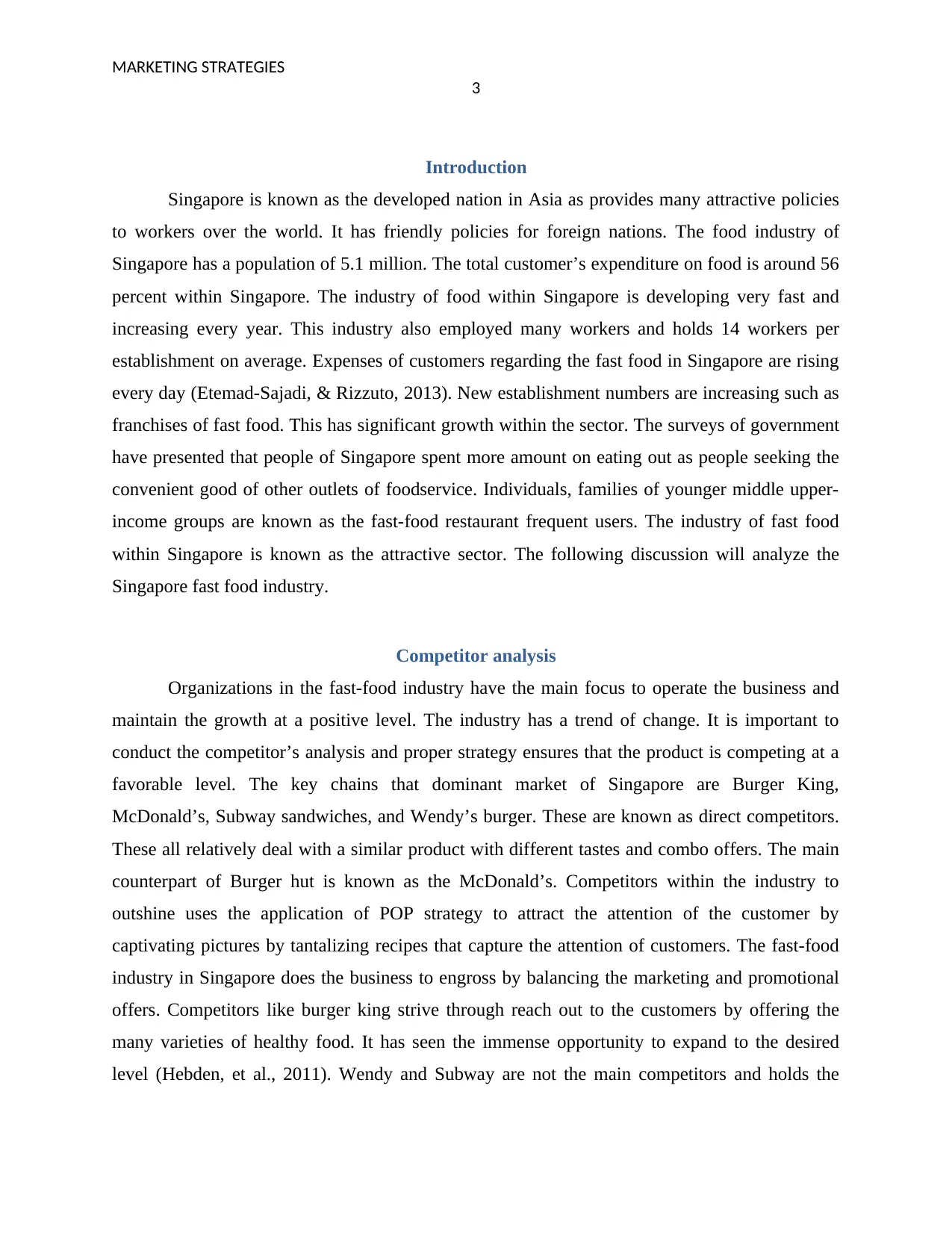
MARKETING STRATEGIES
3
Introduction
Singapore is known as the developed nation in Asia as provides many attractive policies
to workers over the world. It has friendly policies for foreign nations. The food industry of
Singapore has a population of 5.1 million. The total customer’s expenditure on food is around 56
percent within Singapore. The industry of food within Singapore is developing very fast and
increasing every year. This industry also employed many workers and holds 14 workers per
establishment on average. Expenses of customers regarding the fast food in Singapore are rising
every day (Etemad-Sajadi, & Rizzuto, 2013). New establishment numbers are increasing such as
franchises of fast food. This has significant growth within the sector. The surveys of government
have presented that people of Singapore spent more amount on eating out as people seeking the
convenient good of other outlets of foodservice. Individuals, families of younger middle upper-
income groups are known as the fast-food restaurant frequent users. The industry of fast food
within Singapore is known as the attractive sector. The following discussion will analyze the
Singapore fast food industry.
Competitor analysis
Organizations in the fast-food industry have the main focus to operate the business and
maintain the growth at a positive level. The industry has a trend of change. It is important to
conduct the competitor’s analysis and proper strategy ensures that the product is competing at a
favorable level. The key chains that dominant market of Singapore are Burger King,
McDonald’s, Subway sandwiches, and Wendy’s burger. These are known as direct competitors.
These all relatively deal with a similar product with different tastes and combo offers. The main
counterpart of Burger hut is known as the McDonald’s. Competitors within the industry to
outshine uses the application of POP strategy to attract the attention of the customer by
captivating pictures by tantalizing recipes that capture the attention of customers. The fast-food
industry in Singapore does the business to engross by balancing the marketing and promotional
offers. Competitors like burger king strive through reach out to the customers by offering the
many varieties of healthy food. It has seen the immense opportunity to expand to the desired
level (Hebden, et al., 2011). Wendy and Subway are not the main competitors and holds the
3
Introduction
Singapore is known as the developed nation in Asia as provides many attractive policies
to workers over the world. It has friendly policies for foreign nations. The food industry of
Singapore has a population of 5.1 million. The total customer’s expenditure on food is around 56
percent within Singapore. The industry of food within Singapore is developing very fast and
increasing every year. This industry also employed many workers and holds 14 workers per
establishment on average. Expenses of customers regarding the fast food in Singapore are rising
every day (Etemad-Sajadi, & Rizzuto, 2013). New establishment numbers are increasing such as
franchises of fast food. This has significant growth within the sector. The surveys of government
have presented that people of Singapore spent more amount on eating out as people seeking the
convenient good of other outlets of foodservice. Individuals, families of younger middle upper-
income groups are known as the fast-food restaurant frequent users. The industry of fast food
within Singapore is known as the attractive sector. The following discussion will analyze the
Singapore fast food industry.
Competitor analysis
Organizations in the fast-food industry have the main focus to operate the business and
maintain the growth at a positive level. The industry has a trend of change. It is important to
conduct the competitor’s analysis and proper strategy ensures that the product is competing at a
favorable level. The key chains that dominant market of Singapore are Burger King,
McDonald’s, Subway sandwiches, and Wendy’s burger. These are known as direct competitors.
These all relatively deal with a similar product with different tastes and combo offers. The main
counterpart of Burger hut is known as the McDonald’s. Competitors within the industry to
outshine uses the application of POP strategy to attract the attention of the customer by
captivating pictures by tantalizing recipes that capture the attention of customers. The fast-food
industry in Singapore does the business to engross by balancing the marketing and promotional
offers. Competitors like burger king strive through reach out to the customers by offering the
many varieties of healthy food. It has seen the immense opportunity to expand to the desired
level (Hebden, et al., 2011). Wendy and Subway are not the main competitors and holds the
Secure Best Marks with AI Grader
Need help grading? Try our AI Grader for instant feedback on your assignments.
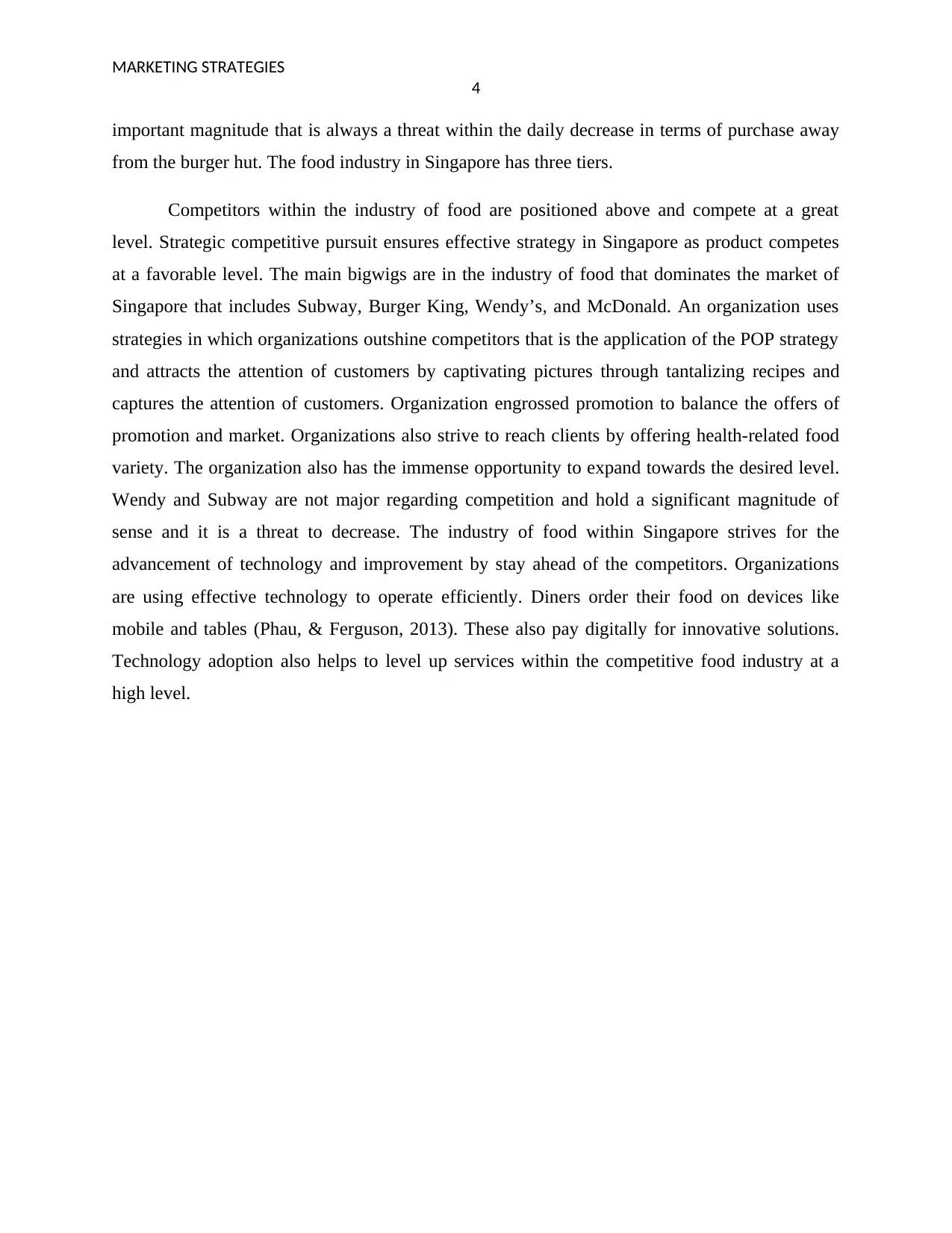
MARKETING STRATEGIES
4
important magnitude that is always a threat within the daily decrease in terms of purchase away
from the burger hut. The food industry in Singapore has three tiers.
Competitors within the industry of food are positioned above and compete at a great
level. Strategic competitive pursuit ensures effective strategy in Singapore as product competes
at a favorable level. The main bigwigs are in the industry of food that dominates the market of
Singapore that includes Subway, Burger King, Wendy’s, and McDonald. An organization uses
strategies in which organizations outshine competitors that is the application of the POP strategy
and attracts the attention of customers by captivating pictures through tantalizing recipes and
captures the attention of customers. Organization engrossed promotion to balance the offers of
promotion and market. Organizations also strive to reach clients by offering health-related food
variety. The organization also has the immense opportunity to expand towards the desired level.
Wendy and Subway are not major regarding competition and hold a significant magnitude of
sense and it is a threat to decrease. The industry of food within Singapore strives for the
advancement of technology and improvement by stay ahead of the competitors. Organizations
are using effective technology to operate efficiently. Diners order their food on devices like
mobile and tables (Phau, & Ferguson, 2013). These also pay digitally for innovative solutions.
Technology adoption also helps to level up services within the competitive food industry at a
high level.
4
important magnitude that is always a threat within the daily decrease in terms of purchase away
from the burger hut. The food industry in Singapore has three tiers.
Competitors within the industry of food are positioned above and compete at a great
level. Strategic competitive pursuit ensures effective strategy in Singapore as product competes
at a favorable level. The main bigwigs are in the industry of food that dominates the market of
Singapore that includes Subway, Burger King, Wendy’s, and McDonald. An organization uses
strategies in which organizations outshine competitors that is the application of the POP strategy
and attracts the attention of customers by captivating pictures through tantalizing recipes and
captures the attention of customers. Organization engrossed promotion to balance the offers of
promotion and market. Organizations also strive to reach clients by offering health-related food
variety. The organization also has the immense opportunity to expand towards the desired level.
Wendy and Subway are not major regarding competition and hold a significant magnitude of
sense and it is a threat to decrease. The industry of food within Singapore strives for the
advancement of technology and improvement by stay ahead of the competitors. Organizations
are using effective technology to operate efficiently. Diners order their food on devices like
mobile and tables (Phau, & Ferguson, 2013). These also pay digitally for innovative solutions.
Technology adoption also helps to level up services within the competitive food industry at a
high level.
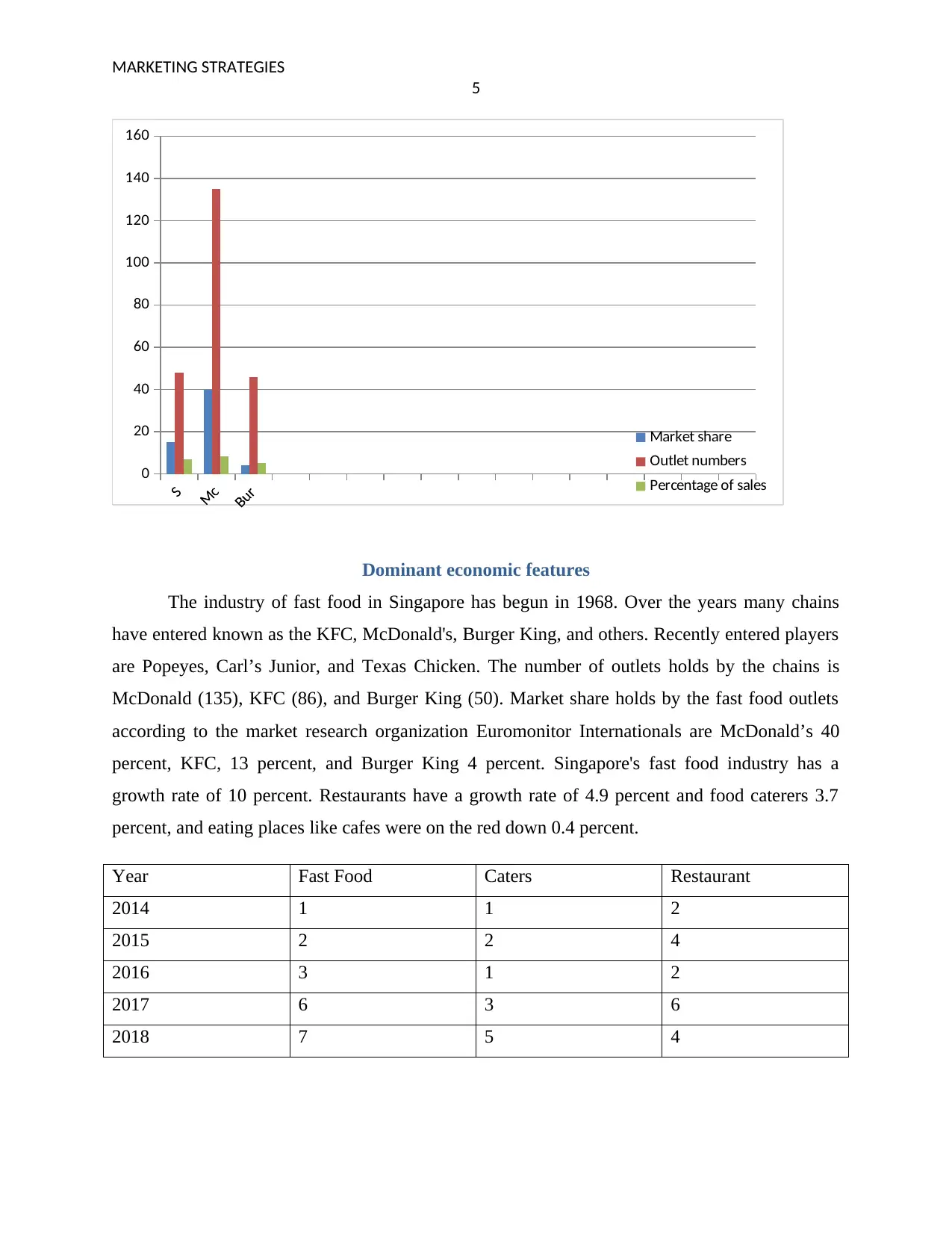
MARKETING STRATEGIES
5
0
20
40
60
80
100
120
140
160
Market share
Outlet numbers
Percentage of sales
Dominant economic features
The industry of fast food in Singapore has begun in 1968. Over the years many chains
have entered known as the KFC, McDonald's, Burger King, and others. Recently entered players
are Popeyes, Carl’s Junior, and Texas Chicken. The number of outlets holds by the chains is
McDonald (135), KFC (86), and Burger King (50). Market share holds by the fast food outlets
according to the market research organization Euromonitor Internationals are McDonald’s 40
percent, KFC, 13 percent, and Burger King 4 percent. Singapore's fast food industry has a
growth rate of 10 percent. Restaurants have a growth rate of 4.9 percent and food caterers 3.7
percent, and eating places like cafes were on the red down 0.4 percent.
Year Fast Food Caters Restaurant
2014 1 1 2
2015 2 2 4
2016 3 1 2
2017 6 3 6
2018 7 5 4
5
0
20
40
60
80
100
120
140
160
Market share
Outlet numbers
Percentage of sales
Dominant economic features
The industry of fast food in Singapore has begun in 1968. Over the years many chains
have entered known as the KFC, McDonald's, Burger King, and others. Recently entered players
are Popeyes, Carl’s Junior, and Texas Chicken. The number of outlets holds by the chains is
McDonald (135), KFC (86), and Burger King (50). Market share holds by the fast food outlets
according to the market research organization Euromonitor Internationals are McDonald’s 40
percent, KFC, 13 percent, and Burger King 4 percent. Singapore's fast food industry has a
growth rate of 10 percent. Restaurants have a growth rate of 4.9 percent and food caterers 3.7
percent, and eating places like cafes were on the red down 0.4 percent.
Year Fast Food Caters Restaurant
2014 1 1 2
2015 2 2 4
2016 3 1 2
2017 6 3 6
2018 7 5 4
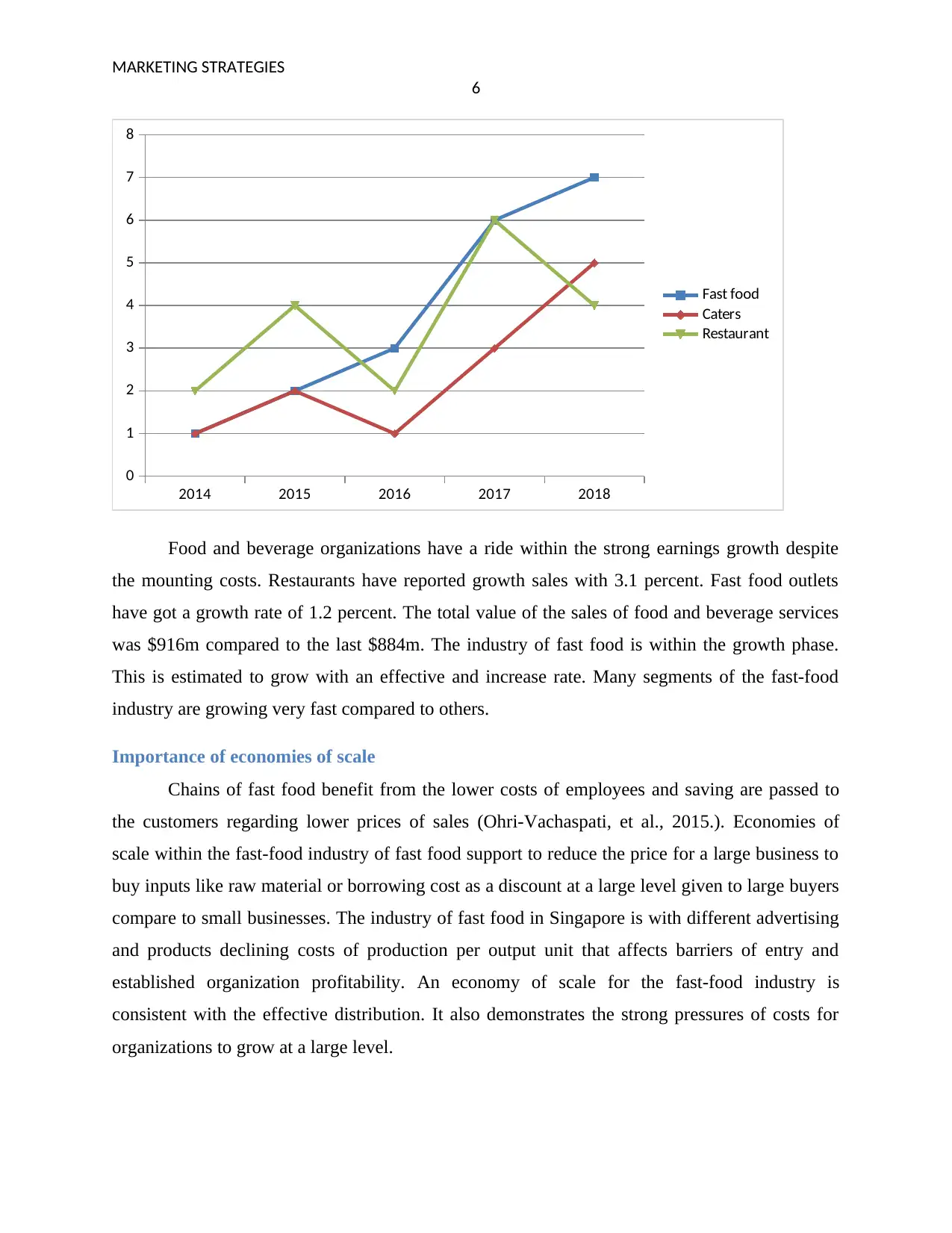
MARKETING STRATEGIES
6
2014 2015 2016 2017 2018
0
1
2
3
4
5
6
7
8
Fast food
Caters
Restaurant
Food and beverage organizations have a ride within the strong earnings growth despite
the mounting costs. Restaurants have reported growth sales with 3.1 percent. Fast food outlets
have got a growth rate of 1.2 percent. The total value of the sales of food and beverage services
was $916m compared to the last $884m. The industry of fast food is within the growth phase.
This is estimated to grow with an effective and increase rate. Many segments of the fast-food
industry are growing very fast compared to others.
Importance of economies of scale
Chains of fast food benefit from the lower costs of employees and saving are passed to
the customers regarding lower prices of sales (Ohri-Vachaspati, et al., 2015.). Economies of
scale within the fast-food industry of fast food support to reduce the price for a large business to
buy inputs like raw material or borrowing cost as a discount at a large level given to large buyers
compare to small businesses. The industry of fast food in Singapore is with different advertising
and products declining costs of production per output unit that affects barriers of entry and
established organization profitability. An economy of scale for the fast-food industry is
consistent with the effective distribution. It also demonstrates the strong pressures of costs for
organizations to grow at a large level.
6
2014 2015 2016 2017 2018
0
1
2
3
4
5
6
7
8
Fast food
Caters
Restaurant
Food and beverage organizations have a ride within the strong earnings growth despite
the mounting costs. Restaurants have reported growth sales with 3.1 percent. Fast food outlets
have got a growth rate of 1.2 percent. The total value of the sales of food and beverage services
was $916m compared to the last $884m. The industry of fast food is within the growth phase.
This is estimated to grow with an effective and increase rate. Many segments of the fast-food
industry are growing very fast compared to others.
Importance of economies of scale
Chains of fast food benefit from the lower costs of employees and saving are passed to
the customers regarding lower prices of sales (Ohri-Vachaspati, et al., 2015.). Economies of
scale within the fast-food industry of fast food support to reduce the price for a large business to
buy inputs like raw material or borrowing cost as a discount at a large level given to large buyers
compare to small businesses. The industry of fast food in Singapore is with different advertising
and products declining costs of production per output unit that affects barriers of entry and
established organization profitability. An economy of scale for the fast-food industry is
consistent with the effective distribution. It also demonstrates the strong pressures of costs for
organizations to grow at a large level.
Paraphrase This Document
Need a fresh take? Get an instant paraphrase of this document with our AI Paraphraser
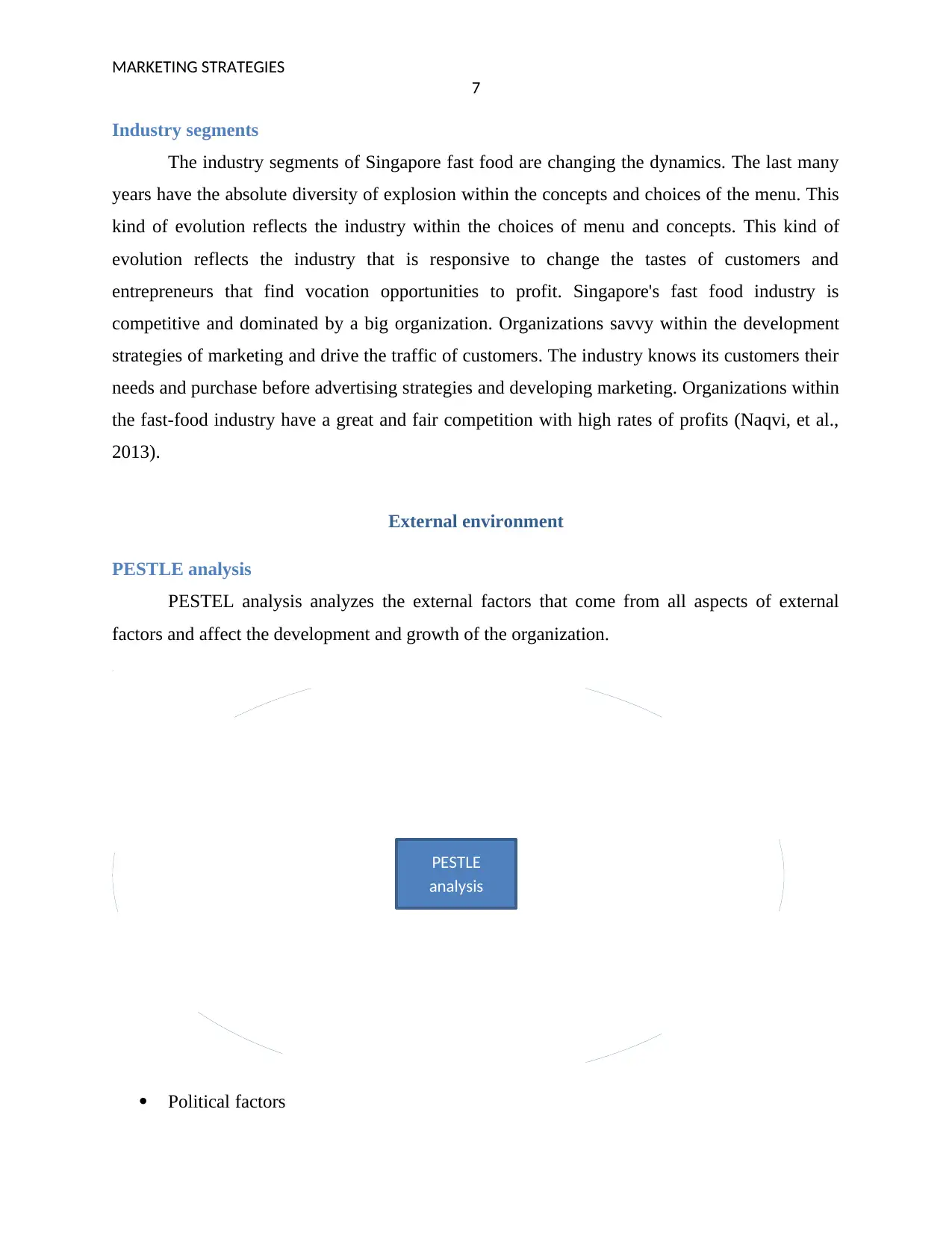
MARKETING STRATEGIES
7
Industry segments
The industry segments of Singapore fast food are changing the dynamics. The last many
years have the absolute diversity of explosion within the concepts and choices of the menu. This
kind of evolution reflects the industry within the choices of menu and concepts. This kind of
evolution reflects the industry that is responsive to change the tastes of customers and
entrepreneurs that find vocation opportunities to profit. Singapore's fast food industry is
competitive and dominated by a big organization. Organizations savvy within the development
strategies of marketing and drive the traffic of customers. The industry knows its customers their
needs and purchase before advertising strategies and developing marketing. Organizations within
the fast-food industry have a great and fair competition with high rates of profits (Naqvi, et al.,
2013).
External environment
PESTLE analysis
PESTEL analysis analyzes the external factors that come from all aspects of external
factors and affect the development and growth of the organization.
Political factors
PoliticalfactorsEconomicfactorsSocialfactorsTechnologicalfactorsEnvironmentalfactorsLegalfactors
PESTLE
analysis
7
Industry segments
The industry segments of Singapore fast food are changing the dynamics. The last many
years have the absolute diversity of explosion within the concepts and choices of the menu. This
kind of evolution reflects the industry within the choices of menu and concepts. This kind of
evolution reflects the industry that is responsive to change the tastes of customers and
entrepreneurs that find vocation opportunities to profit. Singapore's fast food industry is
competitive and dominated by a big organization. Organizations savvy within the development
strategies of marketing and drive the traffic of customers. The industry knows its customers their
needs and purchase before advertising strategies and developing marketing. Organizations within
the fast-food industry have a great and fair competition with high rates of profits (Naqvi, et al.,
2013).
External environment
PESTLE analysis
PESTEL analysis analyzes the external factors that come from all aspects of external
factors and affect the development and growth of the organization.
Political factors
PoliticalfactorsEconomicfactorsSocialfactorsTechnologicalfactorsEnvironmentalfactorsLegalfactors
PESTLE
analysis
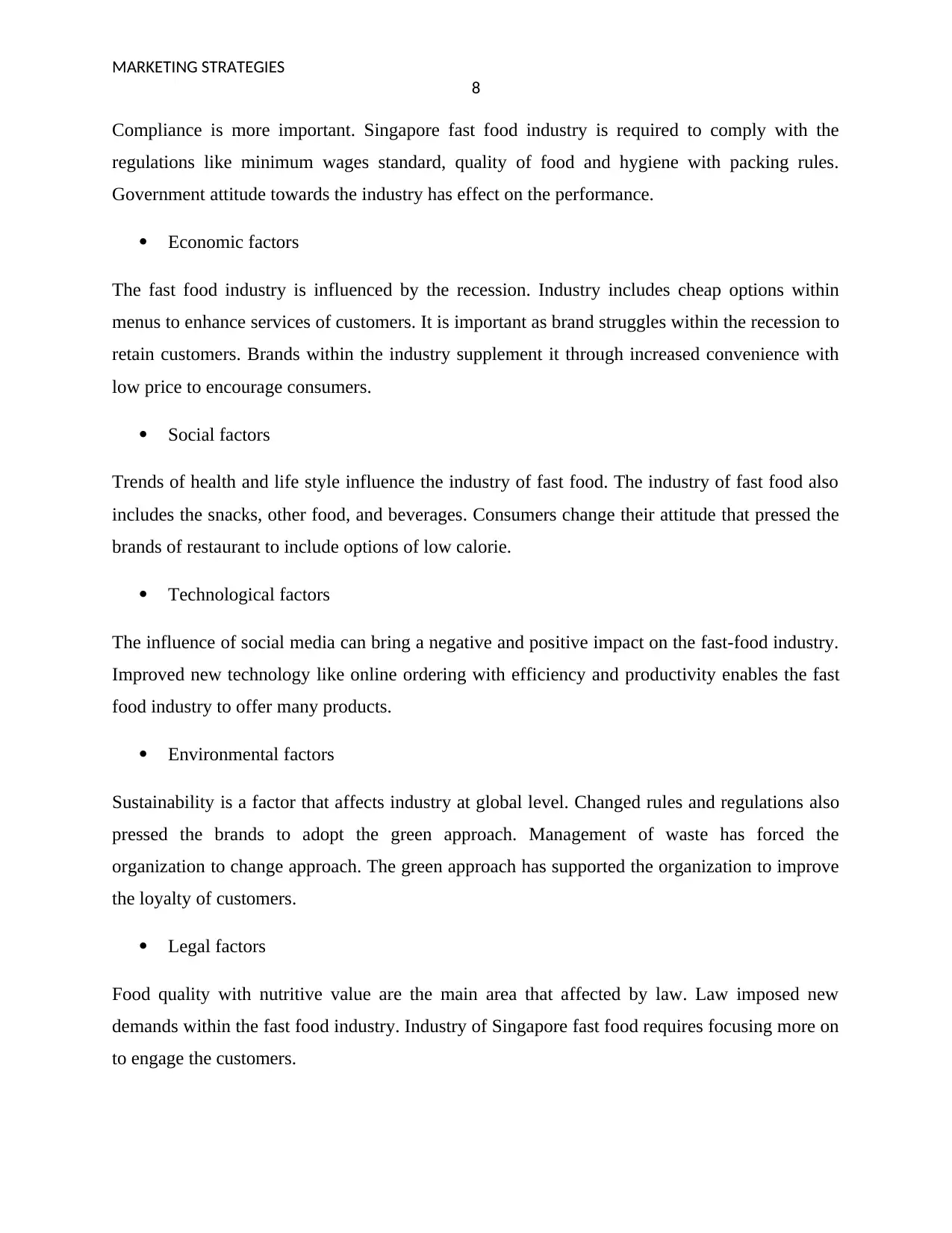
MARKETING STRATEGIES
8
Compliance is more important. Singapore fast food industry is required to comply with the
regulations like minimum wages standard, quality of food and hygiene with packing rules.
Government attitude towards the industry has effect on the performance.
Economic factors
The fast food industry is influenced by the recession. Industry includes cheap options within
menus to enhance services of customers. It is important as brand struggles within the recession to
retain customers. Brands within the industry supplement it through increased convenience with
low price to encourage consumers.
Social factors
Trends of health and life style influence the industry of fast food. The industry of fast food also
includes the snacks, other food, and beverages. Consumers change their attitude that pressed the
brands of restaurant to include options of low calorie.
Technological factors
The influence of social media can bring a negative and positive impact on the fast-food industry.
Improved new technology like online ordering with efficiency and productivity enables the fast
food industry to offer many products.
Environmental factors
Sustainability is a factor that affects industry at global level. Changed rules and regulations also
pressed the brands to adopt the green approach. Management of waste has forced the
organization to change approach. The green approach has supported the organization to improve
the loyalty of customers.
Legal factors
Food quality with nutritive value are the main area that affected by law. Law imposed new
demands within the fast food industry. Industry of Singapore fast food requires focusing more on
to engage the customers.
8
Compliance is more important. Singapore fast food industry is required to comply with the
regulations like minimum wages standard, quality of food and hygiene with packing rules.
Government attitude towards the industry has effect on the performance.
Economic factors
The fast food industry is influenced by the recession. Industry includes cheap options within
menus to enhance services of customers. It is important as brand struggles within the recession to
retain customers. Brands within the industry supplement it through increased convenience with
low price to encourage consumers.
Social factors
Trends of health and life style influence the industry of fast food. The industry of fast food also
includes the snacks, other food, and beverages. Consumers change their attitude that pressed the
brands of restaurant to include options of low calorie.
Technological factors
The influence of social media can bring a negative and positive impact on the fast-food industry.
Improved new technology like online ordering with efficiency and productivity enables the fast
food industry to offer many products.
Environmental factors
Sustainability is a factor that affects industry at global level. Changed rules and regulations also
pressed the brands to adopt the green approach. Management of waste has forced the
organization to change approach. The green approach has supported the organization to improve
the loyalty of customers.
Legal factors
Food quality with nutritive value are the main area that affected by law. Law imposed new
demands within the fast food industry. Industry of Singapore fast food requires focusing more on
to engage the customers.
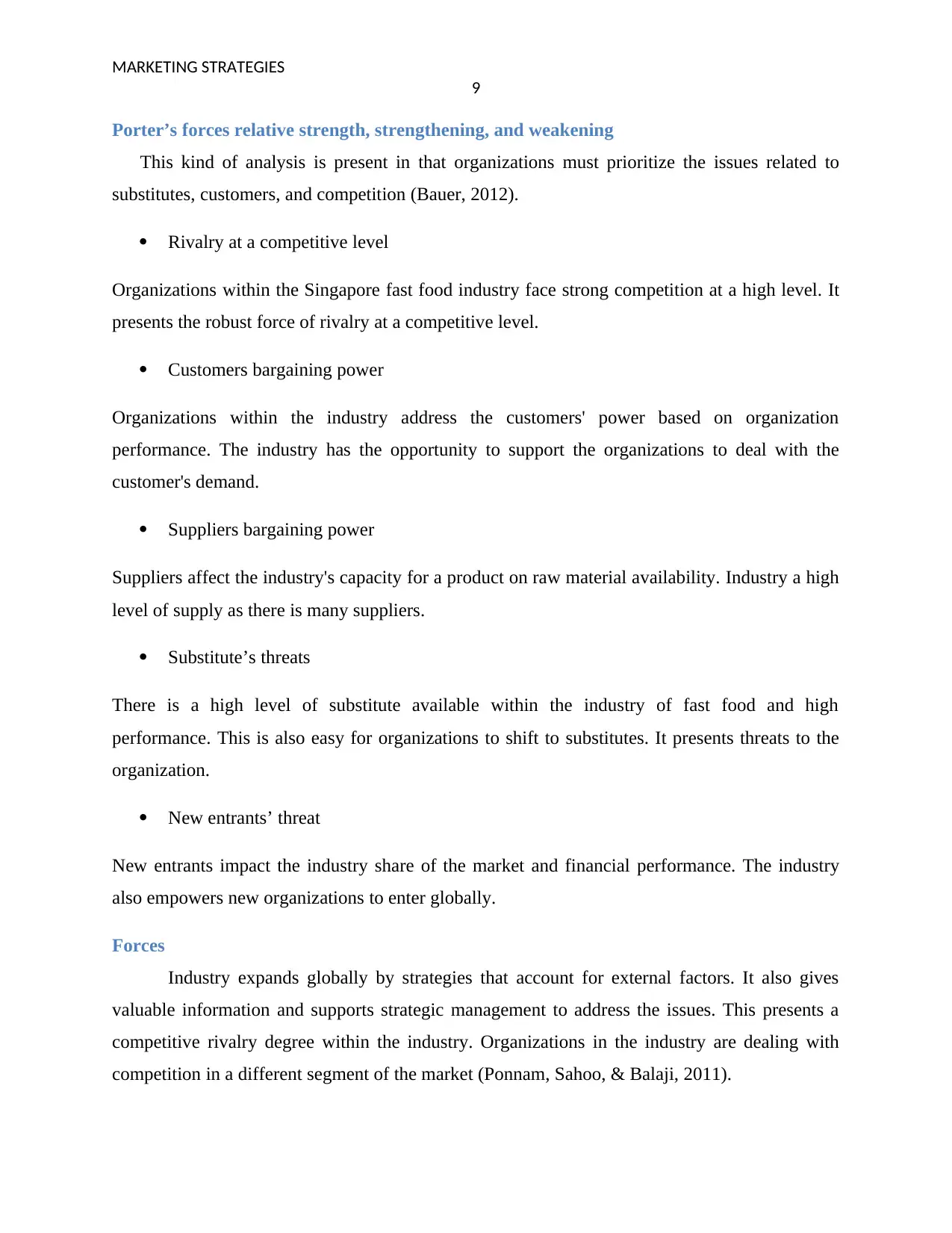
MARKETING STRATEGIES
9
Porter’s forces relative strength, strengthening, and weakening
This kind of analysis is present in that organizations must prioritize the issues related to
substitutes, customers, and competition (Bauer, 2012).
Rivalry at a competitive level
Organizations within the Singapore fast food industry face strong competition at a high level. It
presents the robust force of rivalry at a competitive level.
Customers bargaining power
Organizations within the industry address the customers' power based on organization
performance. The industry has the opportunity to support the organizations to deal with the
customer's demand.
Suppliers bargaining power
Suppliers affect the industry's capacity for a product on raw material availability. Industry a high
level of supply as there is many suppliers.
Substitute’s threats
There is a high level of substitute available within the industry of fast food and high
performance. This is also easy for organizations to shift to substitutes. It presents threats to the
organization.
New entrants’ threat
New entrants impact the industry share of the market and financial performance. The industry
also empowers new organizations to enter globally.
Forces
Industry expands globally by strategies that account for external factors. It also gives
valuable information and supports strategic management to address the issues. This presents a
competitive rivalry degree within the industry. Organizations in the industry are dealing with
competition in a different segment of the market (Ponnam, Sahoo, & Balaji, 2011).
9
Porter’s forces relative strength, strengthening, and weakening
This kind of analysis is present in that organizations must prioritize the issues related to
substitutes, customers, and competition (Bauer, 2012).
Rivalry at a competitive level
Organizations within the Singapore fast food industry face strong competition at a high level. It
presents the robust force of rivalry at a competitive level.
Customers bargaining power
Organizations within the industry address the customers' power based on organization
performance. The industry has the opportunity to support the organizations to deal with the
customer's demand.
Suppliers bargaining power
Suppliers affect the industry's capacity for a product on raw material availability. Industry a high
level of supply as there is many suppliers.
Substitute’s threats
There is a high level of substitute available within the industry of fast food and high
performance. This is also easy for organizations to shift to substitutes. It presents threats to the
organization.
New entrants’ threat
New entrants impact the industry share of the market and financial performance. The industry
also empowers new organizations to enter globally.
Forces
Industry expands globally by strategies that account for external factors. It also gives
valuable information and supports strategic management to address the issues. This presents a
competitive rivalry degree within the industry. Organizations in the industry are dealing with
competition in a different segment of the market (Ponnam, Sahoo, & Balaji, 2011).
Secure Best Marks with AI Grader
Need help grading? Try our AI Grader for instant feedback on your assignments.
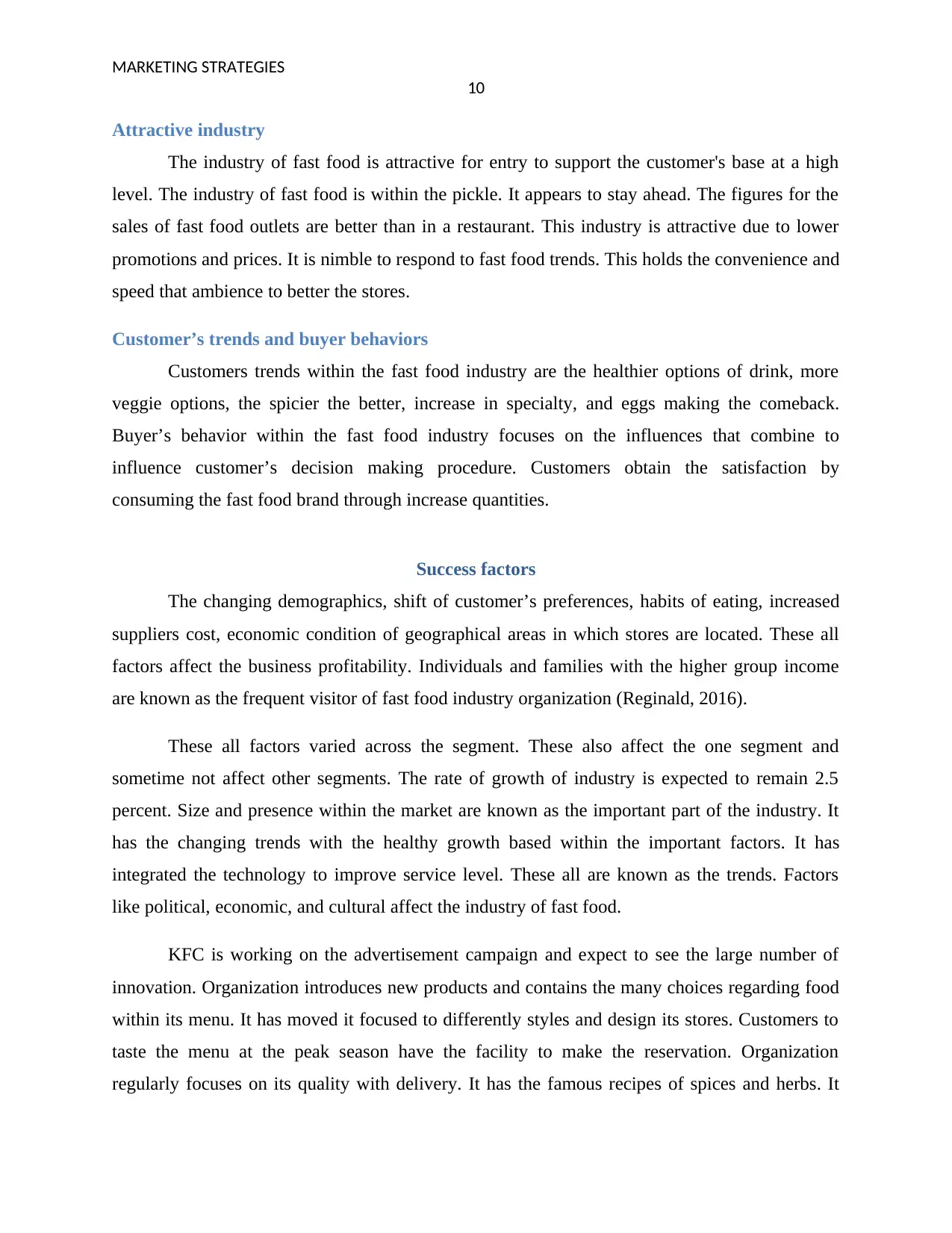
MARKETING STRATEGIES
10
Attractive industry
The industry of fast food is attractive for entry to support the customer's base at a high
level. The industry of fast food is within the pickle. It appears to stay ahead. The figures for the
sales of fast food outlets are better than in a restaurant. This industry is attractive due to lower
promotions and prices. It is nimble to respond to fast food trends. This holds the convenience and
speed that ambience to better the stores.
Customer’s trends and buyer behaviors
Customers trends within the fast food industry are the healthier options of drink, more
veggie options, the spicier the better, increase in specialty, and eggs making the comeback.
Buyer’s behavior within the fast food industry focuses on the influences that combine to
influence customer’s decision making procedure. Customers obtain the satisfaction by
consuming the fast food brand through increase quantities.
Success factors
The changing demographics, shift of customer’s preferences, habits of eating, increased
suppliers cost, economic condition of geographical areas in which stores are located. These all
factors affect the business profitability. Individuals and families with the higher group income
are known as the frequent visitor of fast food industry organization (Reginald, 2016).
These all factors varied across the segment. These also affect the one segment and
sometime not affect other segments. The rate of growth of industry is expected to remain 2.5
percent. Size and presence within the market are known as the important part of the industry. It
has the changing trends with the healthy growth based within the important factors. It has
integrated the technology to improve service level. These all are known as the trends. Factors
like political, economic, and cultural affect the industry of fast food.
KFC is working on the advertisement campaign and expect to see the large number of
innovation. Organization introduces new products and contains the many choices regarding food
within its menu. It has moved it focused to differently styles and design its stores. Customers to
taste the menu at the peak season have the facility to make the reservation. Organization
regularly focuses on its quality with delivery. It has the famous recipes of spices and herbs. It
10
Attractive industry
The industry of fast food is attractive for entry to support the customer's base at a high
level. The industry of fast food is within the pickle. It appears to stay ahead. The figures for the
sales of fast food outlets are better than in a restaurant. This industry is attractive due to lower
promotions and prices. It is nimble to respond to fast food trends. This holds the convenience and
speed that ambience to better the stores.
Customer’s trends and buyer behaviors
Customers trends within the fast food industry are the healthier options of drink, more
veggie options, the spicier the better, increase in specialty, and eggs making the comeback.
Buyer’s behavior within the fast food industry focuses on the influences that combine to
influence customer’s decision making procedure. Customers obtain the satisfaction by
consuming the fast food brand through increase quantities.
Success factors
The changing demographics, shift of customer’s preferences, habits of eating, increased
suppliers cost, economic condition of geographical areas in which stores are located. These all
factors affect the business profitability. Individuals and families with the higher group income
are known as the frequent visitor of fast food industry organization (Reginald, 2016).
These all factors varied across the segment. These also affect the one segment and
sometime not affect other segments. The rate of growth of industry is expected to remain 2.5
percent. Size and presence within the market are known as the important part of the industry. It
has the changing trends with the healthy growth based within the important factors. It has
integrated the technology to improve service level. These all are known as the trends. Factors
like political, economic, and cultural affect the industry of fast food.
KFC is working on the advertisement campaign and expect to see the large number of
innovation. Organization introduces new products and contains the many choices regarding food
within its menu. It has moved it focused to differently styles and design its stores. Customers to
taste the menu at the peak season have the facility to make the reservation. Organization
regularly focuses on its quality with delivery. It has the famous recipes of spices and herbs. It
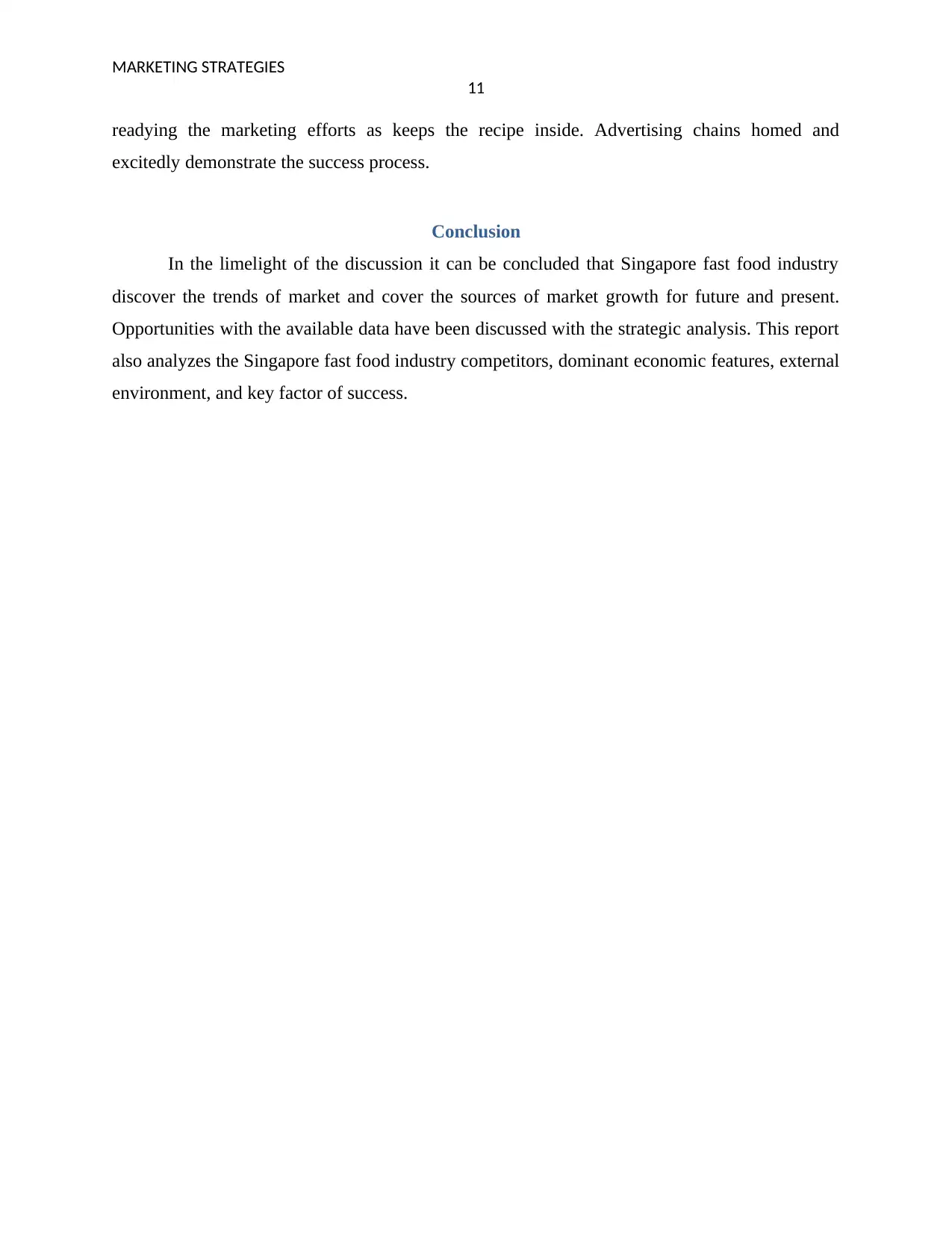
MARKETING STRATEGIES
11
readying the marketing efforts as keeps the recipe inside. Advertising chains homed and
excitedly demonstrate the success process.
Conclusion
In the limelight of the discussion it can be concluded that Singapore fast food industry
discover the trends of market and cover the sources of market growth for future and present.
Opportunities with the available data have been discussed with the strategic analysis. This report
also analyzes the Singapore fast food industry competitors, dominant economic features, external
environment, and key factor of success.
11
readying the marketing efforts as keeps the recipe inside. Advertising chains homed and
excitedly demonstrate the success process.
Conclusion
In the limelight of the discussion it can be concluded that Singapore fast food industry
discover the trends of market and cover the sources of market growth for future and present.
Opportunities with the available data have been discussed with the strategic analysis. This report
also analyzes the Singapore fast food industry competitors, dominant economic features, external
environment, and key factor of success.
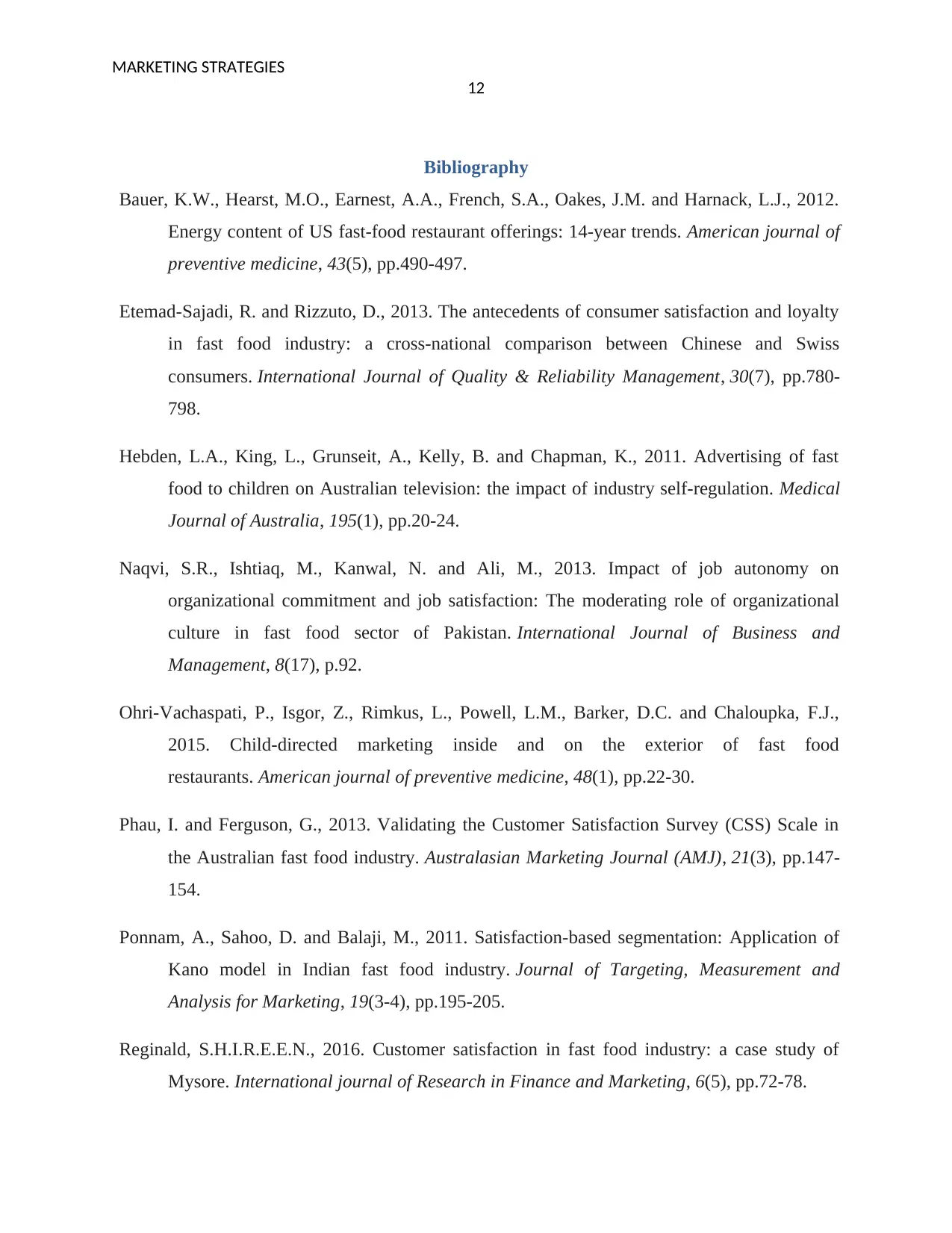
MARKETING STRATEGIES
12
Bibliography
Bauer, K.W., Hearst, M.O., Earnest, A.A., French, S.A., Oakes, J.M. and Harnack, L.J., 2012.
Energy content of US fast-food restaurant offerings: 14-year trends. American journal of
preventive medicine, 43(5), pp.490-497.
Etemad-Sajadi, R. and Rizzuto, D., 2013. The antecedents of consumer satisfaction and loyalty
in fast food industry: a cross-national comparison between Chinese and Swiss
consumers. International Journal of Quality & Reliability Management, 30(7), pp.780-
798.
Hebden, L.A., King, L., Grunseit, A., Kelly, B. and Chapman, K., 2011. Advertising of fast
food to children on Australian television: the impact of industry self‐regulation. Medical
Journal of Australia, 195(1), pp.20-24.
Naqvi, S.R., Ishtiaq, M., Kanwal, N. and Ali, M., 2013. Impact of job autonomy on
organizational commitment and job satisfaction: The moderating role of organizational
culture in fast food sector of Pakistan. International Journal of Business and
Management, 8(17), p.92.
Ohri-Vachaspati, P., Isgor, Z., Rimkus, L., Powell, L.M., Barker, D.C. and Chaloupka, F.J.,
2015. Child-directed marketing inside and on the exterior of fast food
restaurants. American journal of preventive medicine, 48(1), pp.22-30.
Phau, I. and Ferguson, G., 2013. Validating the Customer Satisfaction Survey (CSS) Scale in
the Australian fast food industry. Australasian Marketing Journal (AMJ), 21(3), pp.147-
154.
Ponnam, A., Sahoo, D. and Balaji, M., 2011. Satisfaction-based segmentation: Application of
Kano model in Indian fast food industry. Journal of Targeting, Measurement and
Analysis for Marketing, 19(3-4), pp.195-205.
Reginald, S.H.I.R.E.E.N., 2016. Customer satisfaction in fast food industry: a case study of
Mysore. International journal of Research in Finance and Marketing, 6(5), pp.72-78.
12
Bibliography
Bauer, K.W., Hearst, M.O., Earnest, A.A., French, S.A., Oakes, J.M. and Harnack, L.J., 2012.
Energy content of US fast-food restaurant offerings: 14-year trends. American journal of
preventive medicine, 43(5), pp.490-497.
Etemad-Sajadi, R. and Rizzuto, D., 2013. The antecedents of consumer satisfaction and loyalty
in fast food industry: a cross-national comparison between Chinese and Swiss
consumers. International Journal of Quality & Reliability Management, 30(7), pp.780-
798.
Hebden, L.A., King, L., Grunseit, A., Kelly, B. and Chapman, K., 2011. Advertising of fast
food to children on Australian television: the impact of industry self‐regulation. Medical
Journal of Australia, 195(1), pp.20-24.
Naqvi, S.R., Ishtiaq, M., Kanwal, N. and Ali, M., 2013. Impact of job autonomy on
organizational commitment and job satisfaction: The moderating role of organizational
culture in fast food sector of Pakistan. International Journal of Business and
Management, 8(17), p.92.
Ohri-Vachaspati, P., Isgor, Z., Rimkus, L., Powell, L.M., Barker, D.C. and Chaloupka, F.J.,
2015. Child-directed marketing inside and on the exterior of fast food
restaurants. American journal of preventive medicine, 48(1), pp.22-30.
Phau, I. and Ferguson, G., 2013. Validating the Customer Satisfaction Survey (CSS) Scale in
the Australian fast food industry. Australasian Marketing Journal (AMJ), 21(3), pp.147-
154.
Ponnam, A., Sahoo, D. and Balaji, M., 2011. Satisfaction-based segmentation: Application of
Kano model in Indian fast food industry. Journal of Targeting, Measurement and
Analysis for Marketing, 19(3-4), pp.195-205.
Reginald, S.H.I.R.E.E.N., 2016. Customer satisfaction in fast food industry: a case study of
Mysore. International journal of Research in Finance and Marketing, 6(5), pp.72-78.
1 out of 13
Related Documents
Your All-in-One AI-Powered Toolkit for Academic Success.
+13062052269
info@desklib.com
Available 24*7 on WhatsApp / Email
![[object Object]](/_next/static/media/star-bottom.7253800d.svg)
Unlock your academic potential
© 2024 | Zucol Services PVT LTD | All rights reserved.





